15–20 minute read
Understanding Plant Hardiness
modified from Understanding Cold Hardiness
Understanding Cold Hardiness
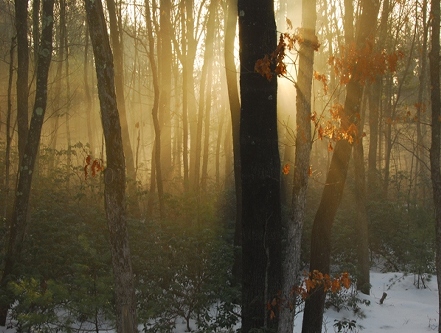
Daylength
You often hear that the only things we can count on are death and taxes, but as fall approaches and the nights are dipping down to the lower half of the brass frog-shaped thermometer I tacked to the porch post, I can add winter to the list. While folks in the tropics swat mosquitoes and sip margaritas on the screened porch, we northerners are stacking wood, putting on storm windows, and changing the oil in the old snow blower. The perennial plants around me also stocking up and preparing for inevitable cold. Many get their first hint of winter’s approach in midsummer, when the days start to shorten. As we shoot fireworks and roast weenies on the hibachi, the nights start to increase in length a minute or two per day. In a world of uncertainty, you can also count on this, and seeing as plants are already highly light sensitive things, it is not surprising that the photoperiod or length of the day is an excellent calendar.
Of course, the farther you live from the equator, the longer your summer days will be. On June 21st, the days in Homer, Alaska are almost 19 hours long, while in Houston, Texas, there are only 14 hours of daylight. By October 21st, the days have dropped to just 9¾ hours in Homer, while they are still 11¾ hours in Houston. Plants native to specific latitudes have tuned their photoperiodic calendars to the place over the eons through natural selection: individuals that miscalculate the arrival of winter are quickly dispatched in favor of those that respond to the shortening days appropriately.
Cold Tolerance
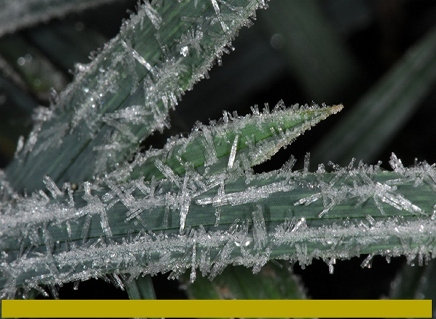 Carex laxiculmis (an evergreen sedge) in early winter
Carex laxiculmis (an evergreen sedge) in early winter
Cold tolerance takes a lot of work to maintain, and plants — even extremely winter-hardy species — loose all cold tolerance during the warm days of summer and then only slowly build it back up again in fall and winter. There is no sense wasting precious resources maintaining cold tolerance when it is not necessary, and even when it is cold, the idea is to stay just a few steps ahead of the chill. Perennial plants go through three stages of winter dormancy: acclimation, mid-winter hardiness, and deacclimation.
Acclimation
During the summer, even very winter-hardy species that can withstand -50°F in January may be killed by just a touch of frost. Decreasing daylength and then decreasing temperatures (especially night temperature) spur the production of ABA and ethylene to ready the perennial for winter. Stem growth slows and carbohydrates are redirected to roots as leaves begin to wither. Mature tissues are more resistant to frosts than young, tender ones, so this is a good first step. Excessive fertilization and watering in late summer raises auxin levels that counteract the effects of the dormancy hormones and delay the onset of early acclimation, making your perennials more vulnerable to early frosts as well as more extreme cold further on.
Mid-winter hardiness
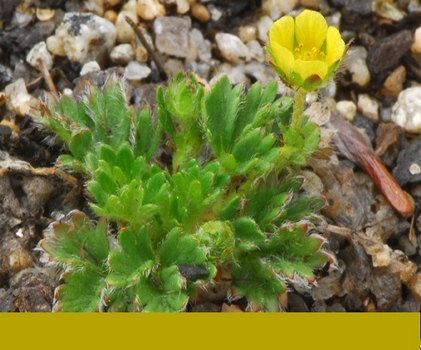 Potentilla robbinsiana — an extremely cold-tolerant alpine from the summit of Mt Washington in NH
Potentilla robbinsiana — an extremely cold-tolerant alpine from the summit of Mt Washington in NH
For perennials to withstand colder temperatures without the benefit of a thick insulating layer of snow, they have to control the formation of ice crystals in their tissues. Very cold-hardy plants (those hardy to USDA zone 3 or -40°F) are able to prevent ice crystal formation in their cells. You have probably heard of planes seeding clouds to produce rain. One technique is to spray silver iodide crystals into clouds. The crystals act as nuclei or nucleation points on which ice crystals begin to grow, and it is these ice crystals that fall as rain once they melt at lower levels of the atmosphere. Ice crystals in cells need nucleation points to begin forming, too, so very cold hardy plants prevent them forming by removing potential nuclei from the cellular and intracellular fluids. Such fluids become in effect supercooled and can withstand temperatures as low as -40°F without damage. Below this temperature, ice crystals will form without nucleation points, and this explain why USDA zone 3 is the lower winter hardiness limit for even many very cold-hardy species. The list of perennials that can survive below -40°F without snow cover is relatively small, but a few high alpine and tundra species can weather temperatures around -60°F (USDA zone 1) with a combination of supercooling and cellular dehydration that removes much of the water from cells that the ice needs to grow. Their cellular membranes are also fairly flexible and resilient so they can resist thrust of ice crystals.
So, winter hardiness is a combination of first the proper recognition of daylength cues and response to cool temperatures to slow and stop growth and build up food stores. Lower water content decrease and cryoprotectants increase to shield the plants from the sub-freezing temperatures that follow, and very cold-hardy species also prevent ice crystal nucleation and growth.
During early acclimation, the plants can weather light frosts, and these light frosts as well as temperatures below 40°F trigger the further cold tolerance to develop. In this later stage of acclimation, temperatures just above freezing, rather than daylength are the important trigger. Ice is of course the big danger to plant cells. Since water expands when it freezes, ice crystals can blow cells apart. Cold-mediated increases in ABA induce plant cells to lose some water and increase concentrations of sugars and other cryoprotectant proteins and alcohols. Like antifreeze in your car, these lower the freezing point of water to 20°F or even 10°F. This corresponds to USDA hardiness zones 8 and 7, and there are many perennials that are hardy to these temperatures. After completing this acclimation process, they are able to withstand hard freezes without harm. If we experience a period of cold in fall followed by 2–4 weeks of unseasonably warm temperatures, plants can actually lose some of their cold tolerance. This happened in much of the Northeast during the winter of 2006–2007. We had record warmth in December and January. I remember going on a family walk in early January with the air temperature approaching 70 degrees. In late January, the temperature abruptly fell and February was very cold with disastrous effects on many typically hardy perennials.
Microclimates
The heat from the earth’s molten core radiates up through the bedrock and actually keeps the temperature of the soil substantially higher than the air temperature, especially if it is covered by an insulating mulch or blanket of snow. As a consequence, roots and other below-ground structures are not nearly as cold-hardy as evergreen leaves, stems and buds. Since most perennials retreat belowground for the winter, root hardiness rather than stem hardiness is the critical factor determining their ability to survive cold. The ubiquitous groundcover Japanese pachysandra (Pachysandra terminalis) is rated as hardy to -30°F, but its roots will die if exposed to merely 15°F.
For nursery growers, root hardiness is a major concern, as the roots are far more exposed to cold in a container than they are in the ground. Growers use insulating blankets, minimally heated greenhouses and other tools to keep pot temperatures from falling below 15 or 20°F. If you garden in the ground, you can still use root temperatures to your advantage when trying to overwinter marginally hardy species. We all know that thick mulches can help retain ground heat and protect sensitive roots and bulbs. Folks with reliable snow cover of more than six inches all winter can often overwinter plants rated a zone or two warmer they should because snow is an excellent insulator. Planting tender species along the foundation of your house where heat leakage from inside keeps the soil just a bit warmer can make all the difference. I once worked at a state research facility that heated all its buildings from one central boiler that distributed steam via underground pipes as needed. The horticulturist was able to overwinter even subtropical plants like bananas in zone 6 when he planted them atop the buried pipes. This didn’t say much about the energy efficiency of this centralized system, but it did raise eyebrows on garden tours.
Since cell dehydration is an important part of the acclimation process, waterlogged soils can lead to winterkill. This is especially true for some taprooted or fleshy rooted perennials as well as bulbs and species native to desert locations. Excessive water in the soil leads to higher than optimal water content of root and stem cells and subsequent freeze damage. Rock gardeners know the value of a very gritty, free-draining soil when it comes to overwintering water-sensitive species. On the other hand, persistent drought in the late summer and early fall can adversely effect the hardiness of other perennials by interfering with carbohydrate buildup in the roots.
Evergreen plants face additional challenges in the winter. When the leaves of Japanese pachysandra or any other evergreen perennial are exposed to the sun when the ground is still frozen, the leaves heat up and lose water through transpiration which the frozen roots re unable to replace. The leaves and stems are often winter-burned (effectively dried out to the point of damage or death). In my area, it is usually not until late February or March, when the sun has regained some of its strength but the ground remains frozen that winter burn occurs. Many evergreen perennials can survive one bad year in three, but the loss of their leaves (and the carbohydrate and nutrient reserves they contain) will weaken the plant and may effect flowering and long term survival.
Deacclimation
While the acclimation process and maximum winter lows are important pieces of the winter hardiness puzzle, deacclimation in spring is just as critical to understand. With the onset of cold weather in late fall, high levels of ABA will prevent fully acclimatized, dormant perennials from resuming growth even if the weather warms. Once the plant has been exposed to a few weeks of sub-freezing temperatures, a spell of unseasonably mild weather will not break dormancy. Only after a genetically predetermined length of cold (anywhere from 1–5 months below 45°F) do levels of ABA drop sufficiently to allow growth to resume.
Christmas rose (Helleborus niger) or Snowdrops (Galanthus spp.) need very little chilling before ABA levels drop and they bloom at the slightest hint of mild weather in midwinter. If cold returns, the plants will slow or stop growing again and resume when temperatures stay above freezing. There are very few plants that risk flowering during the winter, and the ones that do are usually from mild maritime or Mediterranean climates with predictably mild winters (this is the case with Galanthus). Christmas rose, on the other hand, is an alpine species from the mountains of Europe. In its native haunts, it is reliably covered in deep snows all winter that do not melt until spring, so it has little need for additional hormonally induced dormancy.
Even the hardiest perennials begin to lose cold resistance once their dormancy period has been satisfied and milder weather spurs them to undo some of their midwinter preparations: antifreeze levels drop, cells rehydrate, and tender young roots and shoots spring to life. Correctly timing the true onset of spring is critical for plants. Grow too early and risk being killed by a late freeze; grow too late and risk losing ground to competitors. Poorly timed deacclimation is sometimes a problem when we cultivate plants from very different regions or climates. Though we cultivate our northeastern trilliums very successfully, we lose the gorgeous Trillium chloropetalum from California because it begins growing too early during our unpredictable spring and is cut down by frost. The timing of deacclimation, like the other stages of winter hardiness, is fine-tuned by natural selection. Those plants that get it right year after year are the ones most likely to reproduce and pass on their genetic calendar to the next generation.
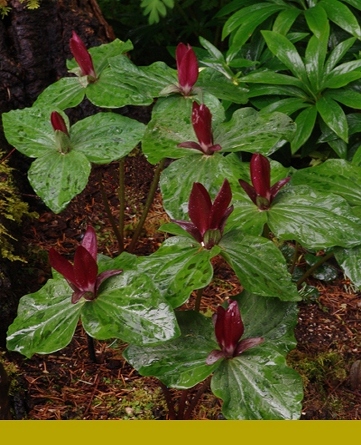 Trillium chloropetalum ‘Berkeley’
Trillium chloropetalum ‘Berkeley’
Conclusion
In conclusion, to be truly winter hardy n your garden, a particular perennial needs to possess the ability to read the approach of fall, build up sufficient countermeasures to combat the damaging effects of ice crystals, winter dampness, and winter burn and to also read the arrival of spring correctly. As the following graph illustrates, a perennial can fail to survive the winter at any of these junctures. Species 1 acclimated well but lacked sufficient extreme cold tolerance to survive the maximum winter low temperature hit in mid-January. Species 2 possessed sufficient cold-tolerance to survive the entire season, while species 3 weathered the extreme cold but deacclimated too quickly in spring and perished during a mid-April freeze.
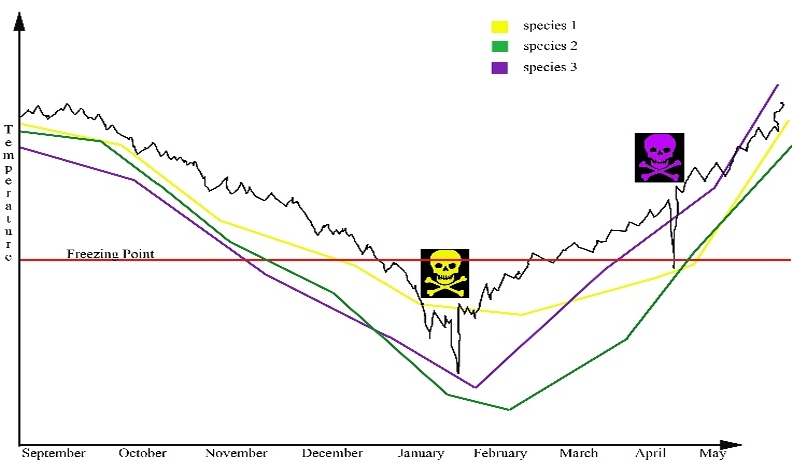
Provenance
Now this is an important point. Hardiness zone ratings reflect only a particular plant’s ability to withstand extreme low mid-winter temperatures. Just because a fully dormant individual rated as hardy to zone 5 can withstand -20°F in January, this does not mean it can read daylength or cooling temperatures correctly in fall or emerge at the proper time in spring. Winter hardiness zone ratings should be used simply as a guide to eliminate completely appropriate species. Even so, remember that hardiness zone ratings are assigned to species with no regard for the variation in true hardiness that it may exhibit over a large natural range. An Arisaema triphyllum ‘Black Jack’ found in the wild in northern Florida will be unlikely to possess zone 3 hardiness of another plant grown from wild Vermont seed. It is only through first hand experience and a lot of dead plants that you can gain a full understanding of how a particular cultivar, species, or genus will behave in your garden. 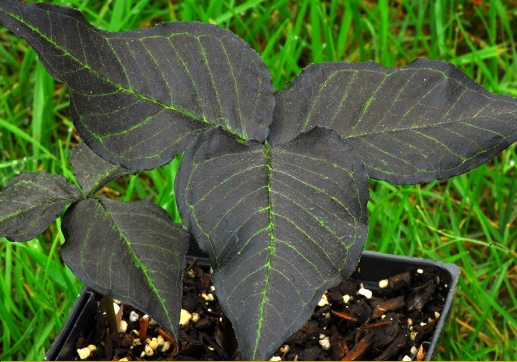 Arisaema triphyllum ‘Black Jack’ {: .figure}
Arisaema triphyllum ‘Black Jack’ {: .figure}